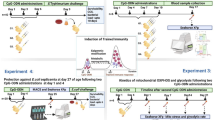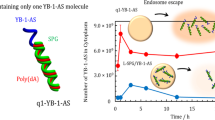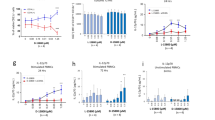Abstract
Aim:
To study the relationship between primary structures of oligodeoxynucleo-tides (ODN) containing unmethylated deoxycytidyl-deoxyguanosine (CpG) dinucleotide motifs and their immunostimulatory activities in mouse spleen cells.
Methods:
A series of CpG ODN with different primary structures were synthesized. Their capabilities to stimulate mouse spleen cell proliferation were determined by [3H]thymidine incorporation assay. Cytokine (interleukin [IL]-6, IL-12, and IFN-α) secretion spectra induced by CpG ODN were assessed by ELISA. The ability of CpG ODN to activate natural killer cells was evaluated by standard 4 h 51Cr-release assay. Flow cytometry was utilized to examine the expressions of various lymphocyte surface molecules on diverse immunocytes. An effective CpG ODN for murine, ODN1826, was set as the template of modification and the positive control.
Results:
The immunostimulatory activities of CpG ODN with different sequences and compositions varied markedly, both in character and in extent. It was useless for improving the immunostimulatory activity of ODN1826 by simply increasing the functional hexameric CpG motif number, modifying the site of CpG motifs, or changing the distance between multi-CpG motifs. However, an addition of a self-complementary palindrome structure at the 3′-end, but not the 5′-end of CpG ODN, aroused marked improvement in its activity. Several designed ODN had superior comprehensive immunostimulatory properties compared to ODN1826.
Conclusion:
The immunostimulatory activity of a CpG ODN was relevant to its primary structure. It was useless for promoting immunostimulatory activity to simply change CpG motif number, space, or distance. The 3′-end palindrome structure of CpG ODN is associated with enhanced immunostimulatory activity.
Similar content being viewed by others
Article PDF
References
Krieg AM, Yi AK, Matson S, Waldschmidt TJ, Bishop GA, Teasdale R, et al. CpG motifs in bacterial DNA trigger direct B-cell activation. Nature 1995; 374: 546–9.
Krieg AM . CpG motifs in bacterial DNA and their immune effects. Annu Rev Immunol 2002; 20: 709–60.
Hartmann G, Weeratna RD, Ballas ZK, Payette P, Blackwell S, Suparto I, et al. Delineation of a CpG phosphorothioate oligodeoxynucleotide for activating primate immune responses in vitro and in vivo. J Immunol 2000; 164: 1617–24.
Krieg AM . An innate immune defense mechanism based on the recognition of CpG motifs in microbial DNA. J Lab Clin Med 1996; 128: 128–33.
Walker PS, Scharton-Kersten T, Krieg AM, Love-Homan L, Rowton ED, Udey MC, et al. Immunostimulatory oligodeoxy-nucleotides promote protective immunity and provide systemic therapy for leishmaniasis via IL-12- and IFN-gamma-dependent mechanisms. Proc Natl Acad Sci USA 1999; 96: 6970–5.
Krieg AM, Yi AK, Hartmann G . Mechanisms and therapeutic applications in DNA vaccines. Trends Microbiol 1999; 6: 23–7.
Ballas ZK, Rasmussen WL, Krieg AM . Induction of NK activity in murine and human cells by CpG motifs in oligodeoxynucleotides and bacterial DNA. J Immunol 1996; 157: 1840–5.
Macfarlane DE, Manzel L . Antagonism of immunostimulatory CpG-oligodeoxynucleotides by quinacrine, chloroquine, and structurally related compounds. J Immunol 1998; 160: 1122–31.
Zhao Q, Matson S, Herrera CJ, Fisher E, Yu H, Kreig AM . Comparison of cellular binding and uptake of antisense phosphodiester, phosphorothioate, and mixed phosphorothioate and methylphos-phonate oligonucleotides. Antisense Res Dev 1993; 3: 53–66.
Dalpke AH, Zimmermann S, Albrecht I, Heeg K . Phospho-diester CpG oligonucleotides as adjuvants: polyguanosine runs enhance cellular uptake and improve immunostimulative activity of phosphodiester CpG oligonucleotides in vitro and in vivo. Immunology 2002; 106: 102–12.
Sester DP, Naik S, Beasley SJ, Hume DA, Stacey KJ . Phosphorothioate backbone modification modulates macrophage activation by CpG DNA. J Immunol 2000; 165: 4165–73.
Lee SW, Song MK, Baek KH, Park Y, Kim JK, Lee CH, et al. Effects of a hexameric deoxyriboguanosine run conjugation into CpG oligodeoxynucleotides on their immunostimulatory potentials. J Immunol 2000; 165: 3631–9.
Verthelyi D, Ishii KJ, Gursel M, Takeshita F, Klinman DM . Human peripheral blood cells differentially recognize and respond to two distinct CpG motifs. J Immunol 2001; 166: 2372–7.
Kadowaki N, Antonenko S, Liu YJ . Distinct CpG DNA and polyi-nosinic-polycytidylic acid double-stranded RNA, respectively, stimulate CD11c type II dendritic precursor and CD11c+ dendritic cells to produce type I IFN. J Immunol 2001; 166: 2291.
Vollmer J, Weeratna R, Payette P, Jurk M, Schetter C, Laucht M, et al. Characterization of three CpG oligodeoxynucleotide classes with distinct immunostimulatory activities. Eur J Immunol 2004; 34: 251–62.
Bao MS, Zhang Y, Wan M, Dai L, Hu XP, Wu XL, et al. Anti-SARS-CoV immunity induced by a novel CpG oligodeoxy-nucleotide. Clin Immunol 2006; 118: 180–7.
Hartmann G, Krieg AM . Mechanism and function of a newly identified CpG DNA motif in human primary B cells. J Immunol 2000; 164: 944–53.
Rankin R, Pontarollo R, Ioannou X, Krieg AM, Hecker R, Babiuk LA, et al. CpG motif identification for veterinary and laboratory species demonstrates that sequence recognition is highly conserved. Antisense Nucleic Acid Drug Dev 2001; 11: 333–40.
Ashman RF . CpG oligodeoxyribonucleotides rescue mature spleen B cells from spontaneous apoptosis and promote cell cycle entry. J Immunol 1998; 160: 5898–906.
Krug A, Rothenfusser S, Hornung V, Jahrsdorfer B, Blackwell S, Ballas ZK, et al. Identification of CpG oligonucleotide sequences with high induction of IFN-alpha/beta in plasmacytoid dendritic cells. Eur J Immunol 2001; 31: 2154–63.
Vollmer J, Weeratna R, Jurk M, Samulowitz U, McCluskie MJ, Payette P, et al. Oligodeoxynucleotides lacking CpG dinucleotides mediate Toll-like receptor 9 dependent T helper type 2 biased immune stimulation. Immunology 2004; 113: 212–23.
Yu D, Zhu FG, Bhagat L, Wang H, Kandimalla ER, Zhang R, et al. Potent CpG oligodeoxynucleotides containing phosphodiester linkages: in vitro and in vivo immunostimulatory properties. Biochem Biophys Res Commun 2002; 297: 83–90.
Zhao Q, Temsamani J, Iadarola PL, Jiang Z, Agrawal S . Effect of different chemically modified oligodeoxynucleotides on immune stimulation. Biochem Pharmacol 1996; 51: 173–82.
Yu D, Zhao Q, Kandimalla ER, Agrawal S . Accessible 5′-end of CpG-containing phosphorothioate oligodeoxynucleotides is essential for immunostimulatory activity. Bioorg Med Chem Lett 2000; 10: 2585–8.
Kandimalla ER, Bhagat L, Yu D, Cong Y, Tang J, Agrawal S . Conjugation of ligands at the 5′-end of CpG DNA affects immuno-stimulatory activity. Bioconjug Chem 2002; 13: 966–74.
Yu D, Kandimalla ER, Bhagat L, Tang JY, Cong Y, Tang J, et al. ′Immunomer′-novel 3′-3′-linked CpG oligodeoxynucleotides as potent immunomodulatory agents. Nucleic Acids Res 2002; 30: 4460–9.
Bhagat L, Zhu FG, Yu D, Tang J, Wang H, Kandimalla ER, et al. CpG penta- and hexadeoxyribonucleotides as potent immuno-modulatory agents. Biochem Biophys Res Commun 2003; 300: 853–61.
Ballas ZK, Kreig AM, Warren T, Rasmussen W, Davis HL, Waldschmidt M, et al. Divergent therapeutic and immunologic effects of oligodeoxynucleotides with distinct CpG motifs. J Immunol 2001; 167: 4878–86.
Vollmer J, Weeratna R, Payette P, Jurk M, Schetter C, Laucht M, et al. Characterization of three CpG oligodeoxynucleotide classes with distinct immunostimulatory activities. Eur J Immunol 2004; 34: 251–62.
Hemmi H, Kaisho T, Takeda K, Akira S . The roles of Toll-like receptor 9, MyD88, and DNA-dependent protein kinase catalytic subunit in the effects of two distinct CpG DNAs on dendritic cell subsets. J Immunol 2003; 170: 3059–64.
Honda K, Ohba Y, Yanai H, Negishi H, Mizutani T, Takaoka A, et al. Spatiotemporal regulation of MyD88-IRF-7 signalling for robust type-I interferon induction. Nature 2005; 434: 1035–40.
Author information
Authors and Affiliations
Corresponding author
Additional information
Project supported by grants from the National Natural Science Foundation of China (No 30500625) and the National High Biotechnology Development Program of China (No 2003AA2Z347B).
Rights and permissions
About this article
Cite this article
Du, Hy., Xia, Sy., Song, Hf. et al. Structure-efficacy relationships of immunostimulatory activity of CpG-containing oligodeoxynucleotides on mouse spleen cells. Acta Pharmacol Sin 28, 1637–1644 (2007). https://doi.org/10.1111/j.1745-7254.2007.00628.x
Received:
Accepted:
Issue date:
DOI: https://doi.org/10.1111/j.1745-7254.2007.00628.x
Keywords
This article is cited by
-
Immunostimulatory and anti-neoplasm effects of a novel palindrome CpG oligodeoxynucleotide in mice
Acta Pharmacologica Sinica (2012)



